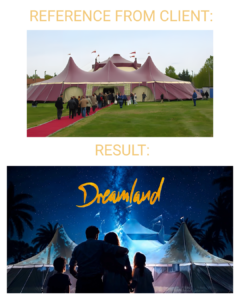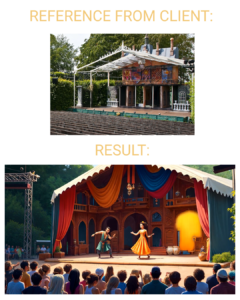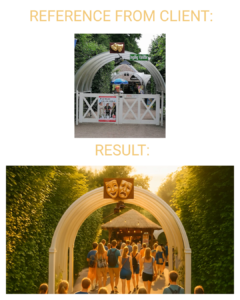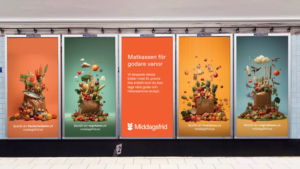Artificial intelligence (AI) has rapidly entered the world of advertising. Today, algorithms can generate photographs, illustrations, and even short films with astonishing realism, something that previously required expensive photo shoots and film crews. Commercials are now created using AI that can mimic human voices or faces, and advertising images can be conjured up on screen from just a simple text prompt. This technological development raises a central question: Is human creativity being overtaken by machines, or is AI instead acting as a catalyst that lifts our creative expression to new heights? This article explores how AI-generated films and images are impacting creativity, costs, ethics, and strategy in advertising and where it might lead the industry in the future.
We’ve now started creating advertising where, together with the client, we can stage the feeling of what’s to come, even before it exists.
Most recently, we created a series of images and films for a musical that has yet to premiere. Starting from the client’s reference photos, we built environments, moods, and moments that reflect the vision and can be used to spark anticipation well in advance.




Creativity in Transformation
An advertising agency’s greatest pride has always been human creativity—the ability to come up with that brilliant idea or unforgettable image that speaks to the audience’s emotions. With AI as a co-creator, both concern and excitement arise. On the pessimist’s side, there’s fear that the artistic spark is lost when machines start doing the work. Some joke that “creativity” may soon become a museum artifact, as AI can now churn out punchy slogans and beautiful image compositions in seconds (formgren.com). Anyone with an internet connection can now generate content that previously required professional expertise, does this mean genuine originality is being sacrificed?
At the same time, there’s another side to the coin: AI can also be a source of inspiration and a tool for creatives. A skilled advertising creator can use AI to quickly produce drafts, ideas, and variations that would have taken days to make manually. At its best, AI functions as a digital creative assistant—offering unexpected visual ideas or helping draft slogans, which the creator can then refine. Some in the industry argue that the human touch becomes even more important when AI handles the basics. As machine-generated visuals and films become commonplace, the uniquely human—rooted in culture, emotion, and storytelling—may become advertising’s true trump card. According to one industry forecast, human creativity will actually become more valuable as AI expands, since people are drawn to the stories and “soul” behind a work. (adweek.com.)

AI as a Creative Assistant
A clear example of how AI can stimulate creative advertising is the 2023 campaign from Swedish meal kit service Middagsfrid. The company used AI to generate surreal images of their meal bags—like one with cauliflower clouds, flying birds, and a tiny bicycle floating above (axfood.se.) The goal was to spark curiosity through a playful contrast between the artificial in the image and the authentic in the product (real groceries in the bag). Middagsfrid’s marketing manager explained that being able to create images this way was something entirely new and creatively groundbreaking—and that it was “especially fun to experiment in this area.” The final campaign appeared in Stockholm’s subway stations and on social media, illustrating how humans and AI can team up to create unexpected visual concepts in advertising.
More Efficient Production and Lower Costs
Beyond the creative aspects, AI offers promises of speed and cost savings. In ad production, creating image and video materials for different markets has traditionally been time-consuming and expensive. A telling example is the travel company Trivago, which previously had to film dozens of versions of the same commercial with different actors to suit various regions. That process became “very costly and slow,” their CEO said (digiday.com).
AI changed the game: one single film could be adapted digitally with localized voice and messaging, no reshoots needed. The result? Campaigns rolled out faster and at a fraction of the cost, while allowing for more experimentation and learning what worked best.
Trivago’s story illustrates a larger trend. Today, AI can produce acceptable content surprisingly cheaply. Ad agencies note that generative AI often reaches 90% of the quality delivered by a human creative team—at just 10% of the cost (adweek.com.)
For businesses, this is tempting: why pay a premium for ads that AI can create almost as well? Simpler ads and mass-produced banner images are especially ripe for automation. At the same time, time is freed up for humans to focus on more advanced tasks that still require finesse, strategy, and human sensibility. As with many technological leaps, automation may both “take over” some jobs and ease others. The result? Creatives might get more time for ideation as routine work is handled by AI—though it also means fewer people are needed for hands-on production.
Ethical Dilemmas and New Questions
The AI-driven advertising boom comes with a host of ethical concerns. One of them is authenticity: can we trust what we see? In 2023, a French telecom company made headlines with a football-themed ad in which AI was used to swap the players’ faces—a so-called deepfake. In Orange Telecom’s campaign for the Women’s World Cup, it was revealed that the impressive football moves seen in the ad—seemingly performed by men—had actually been played by women, with their faces digitally replaced (digiday.com.)
The message was to highlight the women’s team’s performance (and challenge public biases), but the method also showed just how convincing AI manipulation has become.
Such realistic tools could just as easily be misused to spread false messages or fabricate statements from celebrities in ads. The ad industry must balance technical wow-effects with public trust—no one wants to feel deceived by a commercial. There’s already a growing call for clearer guidelines; perhaps AI-generated advertising should be clearly labeled, so audiences know when content is machine-made.
Another ethical issue concerns the right to one’s own likeness and creative work. Fashion company Levi’s faced backlash when they announced plans to use AI-generated models instead of hiring more human models of diverse backgrounds and body types. The aim was to increase diversity in a “more sustainable” way (independent.co.uk.) But critics were quick to respond—asking why Levi’s didn’t just hire real people instead. The company later clarified that the digital figures would complement, not replace, real models. The Levi’s case highlights the dilemma: if AI-generated images replace photographers, actors, or artists, what happens to human talent—and how does the public view the brand ethically?
Further concerns involve copyright and originality. AI systems are trained on vast quantities of images and artworks—many created by artists who never gave consent. Is it acceptable for an ad illustration to be based on a “style” lifted from thousands of unaware creatives? The debate is ongoing, and both tech companies and lawmakers are grappling with where to draw the line in this new AI era.
AI as Analyst and Strategist
AI’s role in advertising goes far beyond creating pretty pictures or short clips. Equally transformative is how it’s used behind the scenes for analysis and decision-making. Modern ad platforms can use AI to process massive amounts of data—something no human could keep up with—to find patterns in consumer behavior and provide actionable insights (formgren.com). Algorithms can, for instance, detect which messages resonate best with a target audience or pinpoint the optimal time of day to show an ad for maximum effect.
This means ad strategies are increasingly being shaped with AI support. A marketing team might use intelligent systems to simulate different campaign outcomes, optimize budgets, or refine audience targeting. Many routine decisions are now automated: AI can adjust bids and placements in real time based on data, ensuring every marketing dollar is used efficiently. Chatbots with advanced language models (like ChatGPT) are taking over much of online customer service, reshaping how brands interact with consumers. All of this automation lets businesses adapt faster to shifting trends. But even here, human oversight is crucial—data can be misinterpreted or carry biases, so asking the right questions and interpreting the results wisely still depends on people.
Future Scenarios for the Ad Industry
What does the future look like in an industry increasingly shaped by smart AI? Likely a mix of the unfamiliar and the familiar. One possible vision is that nearly the entire technical production of ads becomes automated. Imagine a fully autonomous ad robot—an online service trained on decades of award-winning commercials and pop culture references, able to instantly generate a complete campaign for a new product. In this scenario, the creator’s role shifts to that of a curator or editor: someone who oversees the AI, gives it prompts, and selects the best ideas it outputs. Creativity remains—but is expressed in how we use the tool, not necessarily in crafting every element by hand.
Others envision a different—or at least complementary—future: because AI-generated content becomes so common, truly human-made advertising could rise in prestige. Unique artistic styles, real human stories, and handcrafted aesthetics might become premium assets—a way for brands to stand out amid a flood of AI-made visuals (adweek.com.) We may even see a countertrend that emphasizes transparency (“this campaign was made 100% by humans”) as a badge of authenticity.
Most likely, reality will land somewhere in between these extremes. AI will become a natural part of the advertiser’s toolbox—just like digital editing and online ads once did. Some tasks will disappear, but new roles will emerge. With AI, the industry can save money and unlock new creative doors, but how we choose to use the technology will determine whether it becomes a threat to creativity—or a tool that helps unleash even bolder ideas. The answer isn’t fixed—it’s being rewritten in every campaign where humans and machines meet in service of storytelling.
